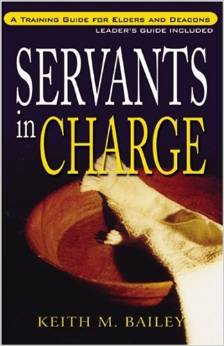Keith Bailey: Servants in Charge

Cover from the 2007 edition
Keith M. Bailey, Servants in Charge: A Training Manual for Elders and Deacons (Camphill, PA: Christian Publications, 1979), 186 pages.
One can find about as many a different ministry philosophies as there are church groups or denominations these days. Leadership styles and structures also seem to abound. Yet the Bible is quite clear on specific areas of church government. Servants in Charge will be a great help to the pastor and local church in developing a strong solid leadership base.
The book, which also contains a study guide, presents a thorough review of biblical qualifications, responsibilities, tasks and giftings required for those who may serve in the elder and deacon offices. Bailey does a good job in noting the spiritual qualities necessary in selecting individuals for a solid leadership team. Deacons are likewise as elders to be spiritual men, and not merely those who handle the material or financial end of the ministry. Elders, on the other hand may play a role in financial oversight as well. In other words while there are distinctive roles to each respective office there may be an overlapping of functions in the local church.
Often when problems arise in a local church there is one basic struggle that must be resolved: Just who is really running the show? Power struggles and leadership styles have ruined numerous churches and many times a pastor has sought to maintain “spiritual authority” by simply ignoring biblical church government or at best relegating the offices to a facade. In Bailey’s view the pastor is an elder but has a position of authority over the other elders of the church and also as executive director will lead the deacons. This establishes a chain of command and a leadership team at the same time. Biblical precedent and support for this position is solidly presented in the book. The tasks and responsibilities of the pastor-elder versus the lay elder are also documented.
Many will find Bailey’s view on the role of the deaconess, and his interpretation of scripture as it regards this subject, to be quite interesting. While he does make good points on the tasks of the deaconess, he maintains that there is a clear distinction between the deacon and the deaconess role. Although some may oppose his view of the deaconess altogether, others may see the distinctions as unwarranted.
As a pastor working with the everyday reality of these offices in the church I can heartily recommend the book as an excellent resource for those looking to find positive and effective advice in forming, developing, and reshaping their leadership team.
Reviewed by Ronald M. Messelink
Category: Ministry, Spring 1999


